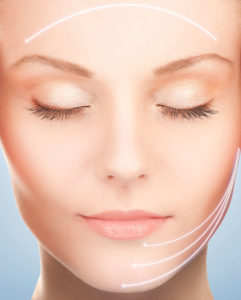Face Lifting (Rhytidectomy) – The surgical procedure of tightening the skin of the face
Aesthetic, Plastic and Reconstructive surgery- of the face

Face lifting or Rhytidectomy is a cosmetic surgical procedure which involves the lifting of the skin of the face, allowing for a younger and “tighter” look. The procedure can lower the elasticity of the skin or wrinkles on the upper part of the cheek/forehead, along the lower part of the jaw line, and other changes that occur on the face over time.
The procedure involves the lifting of the skin on both sides of the face “peeling it back”, with the tissue underneath the skin surgically altered allowing for the contours of the face to return back to their youthful look. The excess of the skin is removed before the seams are closed, allowing for stronger tightened skin.
The “Door of Face lifting” Or “Platysmaplasty” is a procedure that is done as a part of the Rhytidectomy or facelift, in order to minimize the fat deposits, and loose skin around the neck region.
However, the face-lift procedure will not diminish the small fine lines of aging, or of damaged skin due to sun over-exposure.
Why is the facelift preformed?
As you get older, the shape and form of your face changes over time. Your skin becomes less elastic and more loose, and fat deposits increase in some regions of the face. Changes in your face due to aging, can be corrected with a facelift procedure as well as these other changes:
– Relaxed formation around the cheeks
– excess skin around the lower jaw line
– Deep nasolabial wrinkles stretching from the both sides of the nose to the corners of the mouth
– Relaxed skin and excess fat around the neck.
How do you prepare yourself for a face-lift?
Other than the standard consultation procedure where you express your expectations and wishes, along with a qualified physician examining your medical records and history, as well as an overview of all medications and supplements you are currently using, other measures are also undertaken before the surgery can proceed.
The surgeon will capture several photographs of your face from different angles, and different sizes. The surgeon will examine your facial bone structure, the shape of your face, the density of fat and skin quality of your face. In order to determine the best surgical approach.
Before coming in for surgery, the patient should wash their hair and face with a germicidal shampoo in the morning.
You will be asked not to eat anything after midnight, on the night before the surgery is to take place. You will be able to drink water and take the appropriate doctor recommended medication.
What does the Face-lift process look like?
The face-lift procedure is done under local anesthesia. Generally, this procedure of surgical tightening of the face implies raising of the skin, tightening of the tissue and muscles beneath it. The fat found in the face and neck can be shaped, removed or redistributed. The skin is then carefully and precisely sewn and positioned again over the newer re-designed facial contours, the excess skin is removed, and the wounds that were inflicted from the appropriate cuts are repaired.
Where and how the appropriate incisions and cuts will be made depends on the surgical technique that will be implemented. The available options are as follows:
– The Traditional Face Lift incision begins in the upper frontal part of the temple region along the hair line, and is continued down to the frontal part of the ears and it finishes behind the ears on the lower side of the scalp. The incision can be made on the lower part of the chin, in order to enhance the look of your neck.
– The Limited Incision, which starts at the hairline just above the ear and goes around the front of the ear, but does not extend to the bottom of the head.
–The Neck Sculpting Incision, start at the front of the ear region and continues around the ear to the lower part of the scalp, with is a small cut made just underneath the chin.
The face-lift is a procedure that typically lasts between two to four hours, but it can last longer if there are other cosmetic procedures completed alongside with it.
What are the risks of this procedure?
Facial surgery can like all other surgeries have a variety of complications. Some complications can be solved through different medications, and ointments. Long lasting complications, although rare can create very serious changes to the look of the patient.
The risks of Face-Lifting include:
– Hematomas
– Scars
– Nerve damage
– Hair loss
– Skin loss
As with any other surgery, face-lifting carries with it a risk of a “break-down”, infection, and unwanted complications due to anesthesia. The following factors increase risk in the complications, and unwanted results of the surgery:
– The use of drugs or supplements that function as blood thinners (ginseng, ginko, and other such supplements and drugs)
– Medications that increase levels of blood coagulation. Poorly controlled diabetes and high blood pressure which increase poor post-surgical healing, hematomas, and heart complications. – Smoking may lead to an increase risk of slow wound recovery, development of hematomas and a skin result post procedure.
– Fluctuation in body weight presents a risk as well.
What happens post procedure?
After the face lifting procedure one can expect the following symptoms:
-Dull to Sharp pains
– Wound secretion
– Swelling
-hematomas/bruising
– Stiffness
These symptoms should pass in a few days.
A few days after the operation one should:
– Keep the head in an elevated position
– Take the prescribed pain killer medication
– Keep a cold compression on the face in order to reduce swelling and pain.
In the next two months post-surgery regularly scheduled maintenance visits to your doctor should occur due to the following:
– The day after surgery, your surgeon will likely apply an antibiotic cream on the incisions, and replace your bandages.
– Two to three days post-surgery, elastic bandages may replace the original ones.
– A week after surgery, your doctor will remove the stitches and examine the wounds.
If needed later follow ups with your doctor maybe scheduled.
What can you do to help your post-operative healing process?
Adequate self- care at home for two to three weeks post-surgery will help both with recovery and reduce the risk of complications. One should do the following at home:
– Carefully follow instructions that you have received from your doctor.
– Do not touch the scabs that are growing on your wounds
– Follow instructions on when you can start using shampoos, soaps and what types you are allowed to use.
– Wear clothing that do not cover your head/face.
– Avoid any pressure or unnecessary touching of or around the stitches/wounds.
– Avoid the use of makeup
– Avoid high energy exercises, contact sports and aerobics
– Avoid direct exposure to sunlight for up to 3 weeks, after be sure to wear adequate sunglasses and use a sunscreen of an SPF of a minimum of 30.
– Avoid any hair treatment at minimum 6 weeks post-surgery.
Results of the face-lift procedure.
The results of the face lift will not last forever. With age the skin may start to relax/drop, and lose its elasticity. Generally, it can be concluded that the results of the facelift procedure will last approximately 10 years, which in itself is a very long and fulfilling period.
Questions and answers
- Is it early for face lift?
-
There is no definite time for a facilitation intervention. We have had experiences with patients of different years, in different stages of life and circumstances. The best way to find out if you’re ready is to come to our consultations.
- Can I combine face lifting with other interventions?
-
Of course! Face lifting is often combined with correction of eyelids, eyebrow, grafting, rhinoplasty, or chin correction. In some cases, patients also opt for simultaneous interventions in other parts of the body, in order to reduce the recovery time after surgery. During the first consultation, the doctor will consider all your needs and advise you if you would be eligible for some additional intervention.
- What is the most common recovery time after a face lift?
-
Many patients look and feel well about two weeks after surgery. If you feel comfortable, you can return to work two weeks after surgery, but you need to refrain from physical effort approximately four to six weeks after the intervention.
- Do I have a drain?
-
Drainage is placed after a face lift operation and is worn for a few days. It is most often removed during the first postoperative control.
- How long have the effects of face lift lasted? Will I have to repeat it after a while?
-
As with most other surgical interventions, the results of face lifting usually last for many years, but they are not permanent. After the “Time Reset” you have achieved by face lift, natural aging continues. To maximize the time of visible positive results, it is extremely important to take care of the care and health of your body and skin in the years that follow the face lift. We advise you to use quality skin care products, protect your skin from the sun everyday, eat healthy and engage in physical activity. In addition to beneficial effects for your health, this will also contribute to extending the results of your face lifting.
- Will the scars be visible??
-
The cuts are usually made behind the ears and along the hairline, with the aim of being naughty unnoticed and easily hidden by hair.
- I do not feel ready for this procedure, is there any alternative?
-
There are a number of excellent, but short-term substitutes for face lift, which can not reach the same and current results as feasible, but slight improvements can be achieved.
If you need more information, call our call center on the phone: +381 11 785 88 88 or +381603292411

